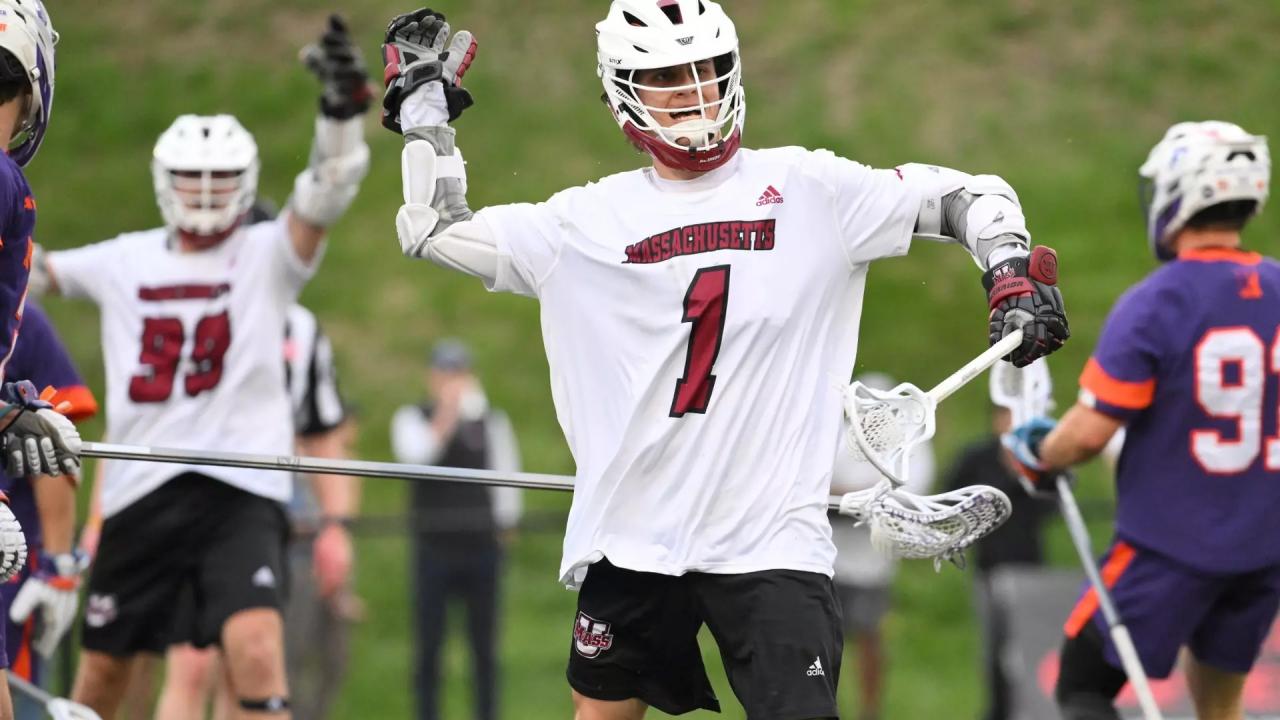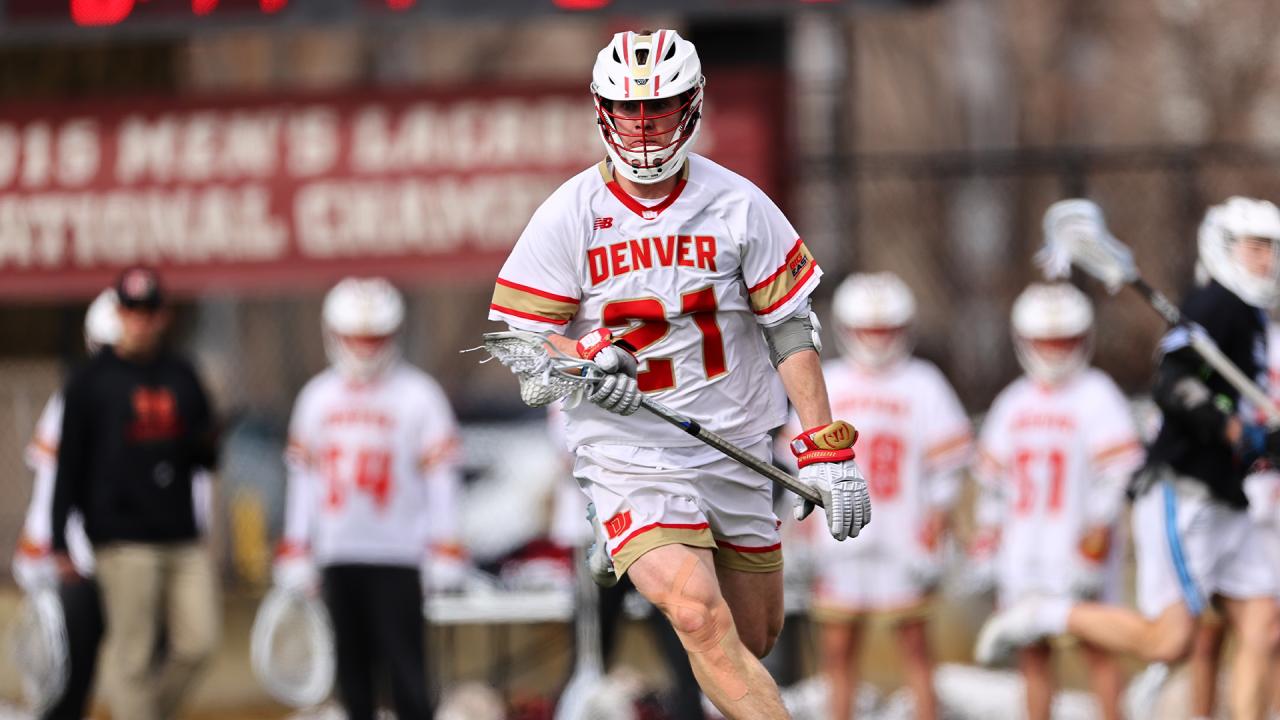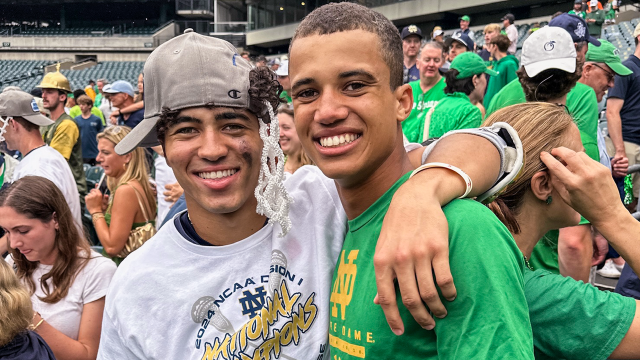

© 2025 USA Lacrosse. All Rights Reserved.

Before USA Lacrosse Magazine looks ahead to what’s to come in 2026, our team of staff and contributors decided it was worth taking one last look at 2025.
After all, you have to look at the most recent results before making projections for what’s to come. To do that, we’re taking a journey through the top 30 teams in men’s and women’s lacrosse — what went right, what went wrong and what we should all think of that team’s season.
Was it a success? A failure? A mixture of both? You’ll find out our thoughts over the next week.
USA Lacrosse preseason/postseason ranking: Unranked/Unranked
2025 record: 9-6 (2-3 Atlantic 10)
What went right: The Minutemen were stingy on defense, ranking 14th nationally in fewest goals allowed per game while limiting opponents to 25.4 percent shooting. Their specialty units were stout, ranking fourth in man-up offense and 10th on the man down, joining Virginia as the only teams to crack the top 10 in both. Merrimack transfer Trace Hogan instantly became the central figure on offense and finished with 28 goals and 31 assists. Owen Salanger started all but one game and posted a .565 save percentage.
What went wrong: Mainly, the calendar turned to April. The Minutemen had a seven-game winning streak during non-conference play and improved to 8-2 when they beat Saint Joseph’s in their Atlantic 10 opener. But UMass would drop four of its last five, giving up at least 14 goals in each loss in that stretch. The season ended with a season-low offensive output in a 14-4 loss to Richmond in the Atlantic 10 semifinal.
Season highlight: An 11-7 victory at Rutgers on March 15 was probably the Minutemen’s most valuable triumph in retrospect, though in real time, the defeat of Saint Joseph’s in late March felt like a considerable statement against the defending A-10 champions.
Verdict: UMass won nine games for the first time since 2019, so it’s worthwhile to acknowledge the year-over-year progress. It’s still a young-ish roster, and Salanger looks like the latest capable Minutemen goalie, so UMass could be on the rise — especially if it can finish stronger than it did this season.
USA Lacrosse preseason/postseason ranking: Unranked/Unranked
2025 record: 9-6 (2-3 Atlantic 10)
What went right: Ben Dutton (47G, 8A) had an outstanding freshman season. Tommy Gross (.569SV%) was superb in the goal and was even better during Atlantic 10 play. The Hawks shook off consecutive losses to open the season by winning seven in a row and eventually improving to 9-3.
What went wrong: The last three weeks. Saint Joseph’s didn’t get to double figures in regular-season losses to High Point (11-9) and Richmond (10-7), or in an A-10 semifinal on its own field against High Point (14-9). Instead of back-to-back NCAA tournament berths and a third in four years, the Hawks were done by May 1. The biggest statistical issue was faceoffs, finishing 70th out of 77 Division I teams at just 41.1 percent.
Season highlight: Saint Joseph’s is the de facto Philadelphia city champion. In a 10-day span in March, the Hawks picked off Drexel (17-11), Villanova (12-8) and Penn (11-10).
Verdict: Nine wins and a conference tournament berth was a cause for celebration a decade ago. Now, it qualifies as a mundane year on Hawk Hill. Consider that a testament to the program Taylor Wray has built, one that had won 10 or more games in each of the three previous seasons.
USA Lacrosse preseason/postseason ranking: No. 20/Unranked
2025 record: 5-10 (4-4 Patriot League)
What went right: Sean Dow won a ton of faceoffs (63.6 percent) and took all but 40 of the Mountain Hawks’ draws. Richard Checo remained a caused turnover machine as a junior, creating 45 takeaways. Fellow defenseman Luke McAuliffe joined him on the Patriot League’s all-conference first team, and redshirt freshman Kasey Heath posted a .551 save percentage while playing every minute of the season. Dakota Eierman (29G, 8A) was a formidable presence in the midfield.
What went wrong: Lehigh committed a ghastly 19.87 turnovers per game (74th out of 77 Division I teams nationally), and when it did manage to avoid giving away possessions, it shot 23.6 percent (68th nationally). That’s a bad formula for any team, and sure enough, the Mountain Hawks averaged a meager 8.87 goals per game to rank 64th in the country in that category. Lehigh scored more than 10 goals just three times; that’s a hard way to go through a season.
Season highlight: Back-to-back victories at Villanova and Navy — the latter featuring a season-high 13-goal outburst — gave some hope Lehigh could revive a year that began with a four-game slide (albeit against a staunch slate of Rutgers, Fairfield, Cornell and Richmond). The Mountain Hawks lost the next two weeks to Army and Bucknell and never got back within two games of .500 the rest of the season.
Verdict: Lehigh’s defense wasn’t flawless, but toss out predictably rough days against Cornell and Princeton and it gave the Mountain Hawks a chance to win pretty much every night. But between the extensive turnovers and the erratic shooting, Lehigh simply couldn’t generate enough goals to string together victories, let alone make a second consecutive NCAA tournament appearance.

USA Lacrosse preseason/postseason ranking: No. 12/Unranked
2025 record: 4-10 (1-5 Ivy League)
What went right: The Quakers went 4-3 in the first half of the season, splitting six non-conference games before beating Brown 9-8 on the opening weekend of Ivy play. And besides that? Not a whole lot.
What went wrong: There simply wasn’t enough offense. Penn reached double figures just five times all season, including just once against Ivy opponents. The absence of Tynan Walsh, the Quakers’ points leader in 2024, for the first half of the season due to injury didn’t help matters. But opportunities were scarcer than Penn would have liked, too. None of the six Quakers to take a faceoff fared better than 45.9 percent, and as a team, they finished at 43.7 percent.
Season highlight: While Delaware had its own disappointing season, Penn’s 10-2 thrashing of the Blue Hens on Feb. 22 in Newark was the Quakers’ most lopsided victory of the year.
Verdict: It was Penn’s worst season since going 3-10 in 2012 — which also happens to be the last time the Quakers finished under .500. That’s a credit to the program’s consistency under Mike Murphy.
Penn also gets credit for being a nuisance even after the season unraveled. It led Princeton 7-4 at halftime on April 19 before the Tigers rallied to win 12-8, and it built a 6-1 advantage at Notre Dame a week later in what turned out to be a 10-8 loss to the Irish. Those competitive showings suggest the Quakers were better than their final record, but they still didn’t contend for an NCAA tournament berth into late April or early May like they usually do.
USA Lacrosse preseason/postseason ranking: No. 10/Also considered
2025 record: 7-7 (2-3 Big East)
What went right: It looked like the Pioneers were turning a corner when they thumped Duke 13-6 in Dallas on March 22. That was one of the few times Denver’s offense and defense were both sharp on the same night. That didn’t always matter; after all, the Pios won 7-3 at eventual Big East top seed Georgetown three weeks later. Individually, Noah Manning (31G, 12A) and Mic Kelly (27G, 8A) had fine senior years, and Casey Wilson remained one of the best short-stick defensive midfielders in the sport.
What went wrong: While Denver was inconsistent all spring, the way it played itself out of the Big East tournament the final two weeks had to be particularly frustrating. The Pioneers managed only two first-half goals — one of them a pass off an opposing defender — in a 10-6 loss to Providence, then they allowed Marquette to shoot nearly 50 percent on the way to an 18-11 drubbing that ended Denver’s season.
Season highlight: The Pioneers simply clobbered Duke, holding the Blue Devils scoreless for a stretch of 42:03 that included all of the second and third quarters and parts of the other two periods. That was Denver at its best, but it could not replicate the level of play often enough.
Verdict: Year two of Matt Brown’s tenure as head coach looked like it could be challenging simply because of the ample graduation losses Denver took from its Memorial Day weekend team in 2024. And sure enough, there was a predictable step back.
But this much? It wasn’t a common offseason sentiment that the Pioneers would miss the conference tournament they were hosting, but that’s how it worked out in what was a chaotic, largely even Big East. With four of its six offensive starters graduating along with Wilson and defenseman Jimmy Freehill, Denver won’t lack for fresh faces next season. And the returning Pioneers certainly won’t need much incentive after their season ended in April this year.
USA Lacrosse preseason/postseason ranking: No. 8/Unranked
2025 record: 5-8 (3-3 Ivy League)
What went right: Leo Johnson (26G, 20A) and Chris Lyons (30G, 11A) had healthy, productive seasons. The Bulldogs had eight players score at least 10 goals. A team that opened the season 1-5 recovered sufficiently enough to get back to .500 and qualify for the Ivy League tournament.
What went wrong: Yale gave up 13.85 goals per game (ranking 69th out of 77 Division I teams in scoring defense). The Bulldogs weren’t much better at clearing the ball, checking in at 81.0 percent (68th nationally). Toss in middle-of-the-road shooting (28.0 percent, 45th in Division I), and the formula wasn’t there to keep pace with the best teams in the Ivy League.
Season highlight: At the time, beating Denver 15-10 on March 8 seemed like a big deal, especially since Yale was 0-3 heading into the game. Considering the Pioneers went on to finish 7-7, a better game to highlight might be the 21-12 trouncing of Dartmouth that ultimately was the difference in extending the Bulldogs’ season into May.
Verdict: Yale finished under .500 for the first time since 2009, when it went 5-9, and missed the NCAA tournament for the second year in a row. Last season, it was remarkable the Bulldogs harbored at-large dreams entering May — given all their injuries, it was almost as if they were being held together by pipe cleaners and Twizzlers by the end. This year, there just wasn’t enough scoring to overcome a defense that has not ranked better than 54th nationally in goals allowed in any of the last four seasons.
Patrick Stevens has covered college sports for 25 years. His work also appears in The Washington Post, Blue Ribbon College Basketball Yearbook and other outlets. He's provided coverage of Division I men's lacrosse to USA Lacrosse Magazine since 2010.










